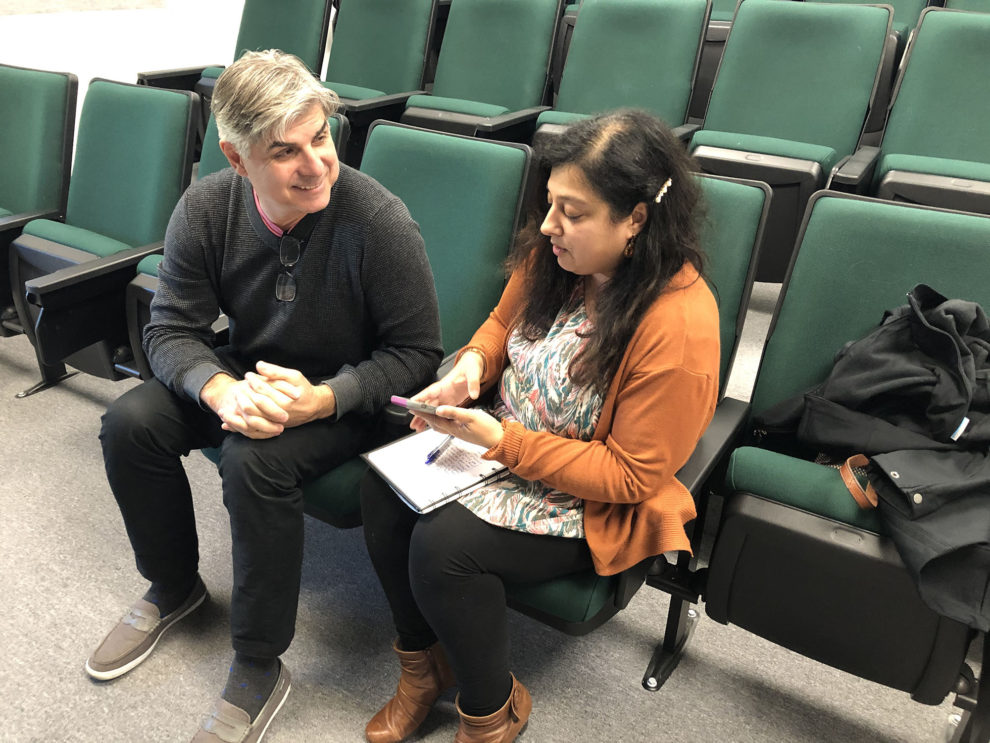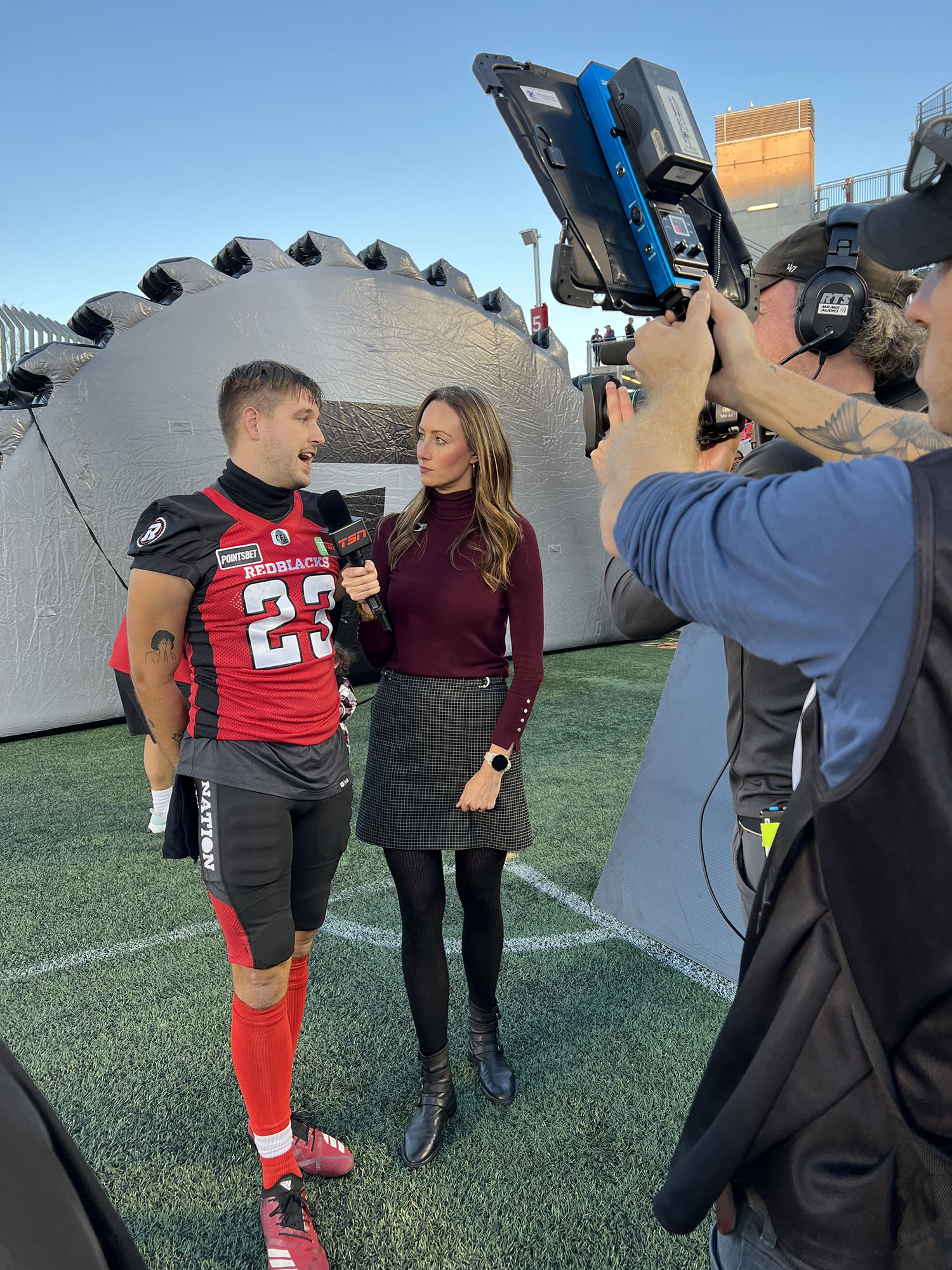Skin in the game

caption
Reporters work at a table.Why more diverse voices are needed in sports reporting
The Los Angeles Rams were at home, taking on the Cincinnati Bengals in Super Bowl LVI. It was February 13, 2022. American football fans were cheering at touchdowns, interceptions, tackles and sacks. Viewers at home were taking in the commercials. Others were ‘Only Here for the Halftime Show,’ their T-shirts referencing the ’90s West Coast hip-hop halftime homage at SoFi stadium in Inglewood, Calif. On the field, the Bengals were up to no good. The Rams nailed a thrilling 23-20 victory, bringing the championship to L.A. after 22 years.
Iliana Limón Romero was tweeting on game day as the Los Angeles Times’ deputy sports editor. She was promoting the commemorative issue, live blog, predictions, interviews and various coverage. On Instagram, she posted a photo of “Today’s office,” the football field.
Three months later, her promotion was announced, becoming the newspaper’s assistant managing sports editor. Limón Romero is the first woman to hold that title at the Times.
She’s a Texan, from El Paso, and attended the University of New Mexico. Her news reporting career started at the Albuquerque Tribune in 2002. Five years later, Limón Romero joined the Orlando Sentinel. She spent nearly 14 years there: five as a sports reporter, before becoming the college sports and pro soccer editor in 2012.
Limón Romero wanted to “help make leadership decisions” and collaborate with colleagues “to do interesting, creative, fun, and innovative things,” she says.
Her hard news background helped Limón Romero cover the June 2016 Pulse nightclub shooting — the deadliest mass shooting in U.S. history at the time. The Sentinel team was a 2017 Pulitzer Prize finalist for breaking news.
Joining the L.A. newsroom in March 2021, her priorities include investigative sports journalism, in-depth coverage and innovative bilingual — English and Spanish — digital storytelling.
View this post on Instagram
Limón Romero is the only Latina sports editor at a major U.S. newspaper.
“I’m the first Mexican-American, which is significant in this city that’s [49] per cent Latino and predominantly Mexican-American,” says Limón Romero. Latinos made up 40 per cent of California’s population in 2021, according to the Pew Research Center.
She adds, “Those statistics are really problematic, and I would like to change them. I would like for that not to be a thing anymore.”
In U.S. and Canadian sports media, the dominant voice has historically been straight, white and male. Depending on the sport, athletes are often racialized. A smaller number are 2SLGBTQ+. Or both. Some are straight women who still don’t receive enough pay or respect. Their stories aren’t being told by enough people like them.
Improving grades
The Institute for Diversity and Ethics in Sport (TIDES) at the University of Central Florida releases a comprehensive report card every two years. It breaks down sports media demographics for roles including sports reporters, editors, columnists and web specialists.
Its 2021 Sports Media Racial and Gender Report Card: Associated Press Sports Editors (APSE) examines the make up of more than 100 newspapers and websites across the U.S. and Canada.
The numbers are shifting versus 2018. For sports editors roles, white men sat at 68 per cent, down 11 percentage points. Journalists of colour increased six points to 21 per cent. White women comprised 12 per cent, up five points. Latinas decreased to 1.7 per cent, from 2.5 percent.
ESPN employed one-quarter of all women in this position. Hispanic/Latinx journalists worked at Yahoo, ESPN and the Miami Herald — though it’s unclear how many were female.
Malika Andrews made history last night as the first woman ever to host the @nba draft. #NBADraft2022 #NBADraft pic.twitter.com/T4IselF1sl
— TIDES (@TIDES_Org) June 24, 2022
In the report, Lisa Wilson, former APSE president and key advisor to the study, stated women need to be making coverage and hiring decisions. Having diverse voices in sports media “remains a major problem for women and especially” women of colour. The report card doesn’t include data on transgender and non-binary reporters.
Its earliest version was published in 2006 and compiled newspaper demographics. White men ruled the sports section. Primary author Richard Lapchick stated “we clearly do not have a group that reflects America’s workforce.” Journalists, he continued, cover a “disproportionate number of athletes in basketball, football and baseball who are African-American or Latino.” Ninety per cent of sports columnists in the U.S. were white. More than 40 per cent of high school and college athletes were female.
Diverse perspectives could “lead writers to ask questions or look at angles that might shed light on the particular situation of an African-American, Latino or female coach or athlete,” Lapchick stated. “The chance to make the stories more interesting and, in some cases, more accurate, should be apparent.” Story assignments and angles would be different if a newsroom was “more representative of our athletes and coaches making those decisions.”
Dear white people: Please stop asking us about the “royal family” we don’t have the same admiration for them as you do. pic.twitter.com/icIM821N3G
— Etan Thomas (@etanthomas36) December 4, 2022
What’s with the rage?

caption
Iliana Limón Romero helps lead the award-winning Los Angeles Times sports team.When Limón Romero was in Orlando and named the first female sports editor at the Sentinel, not everyone was cheering. Instead, she received several “super vile” phone threats. “These things had to be reported to police because they were so graphic and racist and over the top,” says Limón Romero.
Harassment doesn’t happen during scrums, she says. It’s targeted during one-on-one interviews, “or where I experienced it the most was through emails and social media … the comments and the backlash was really direct and aggressive.”
It’s become the norm.
The history of women in sports reporting is often traced back to the 1970s, when women first entered the industry. Perhaps the most discussed issue is the fight for female reporters to get access to male locker rooms. Legislation was passed in the U.S. in 1978 granting all reporters equal access to locker rooms. But there was still drama. Abuse, bullying and misogyny weren’t left in the ’80s.
In 2004, Lisa Guerrero was fired as a Monday Night Football sideline reporter after only one season. She faced backlash that nearly drove her to suicide. In 2015, two-time Olympian Jessica Mendoza became the first female analyst on ESPN in an MLB postseason game, facing immense backlash on social media. In 2020, Leah Hextall received death threats after becoming the first woman to call play-by-play for a nationally televised NHL game.
Ameeta Vohra knows about sexism and racism. She’s based in Halifax and remembers working in a newsroom where sports stories would often go to male colleagues. “And I would have more seniority than this person,” she says.

caption
Ameeta Vohra interviews former Halifax Mooseheads coach J.J. Daigneault in October 2019.She faces a “double-edged sword” for being racialized. In the football world, “I felt at times that I was being attacked or bullied, like, in the way they would answer things,” she says. Vohra had to take a break from the sport, finding hockey and soccer more welcoming.
One of the keys to getting more women into sports media is educating newsrooms about how to “make spaces safe, inclusive and welcoming,” Vohra says. She believes newsrooms should appoint someone for journalists from equity-deserving groups to turn to when they face harassment or discrimination.
Next question
Claire Hanna works as a sports reporter with TSN in Ottawa and CTV Regina. She typically covers football and hockey. Hanna believes when reporters look the same, their questions blend. “I think if we had more BIPOC representation or LGBTQ representation, you name it, there would be a really nice variety of questions to players,” says Hanna.
She recalls asking a professional athlete about his sister’s aspirations to represent Team USA “and he gave a great answer,” she says. “But I don’t think the male reporters would have been so conscious of that.”

caption
Philippa York is a transgender sports reporter who covers the pro cycling circuit in Europe. She’s noticed men and women tend to ask different questions. For post-competition interviews, “I think females cover that situation better because they ask more relevant questions,” says York. She believes men and women tend to write differently, pointing out women are more descriptive and focused on emotions in a story.
In Lucie Schoch’s 2013 study, “‘Feminine’ writing: the effect of gender on the work of women sports journalists in the Swiss daily press,” female sports reporters wrote more portrait, magazine, investigation, and interview-type articles than men. In terms of focusing on the report itself, men tended to do so 44 per cent of the time, compared to women at 26 per cent.
Marie Hardin, now dean of the College of Communications at Pennsylvania State University, co-authored a study on coverage of U.S. college basketball. “The research shows how the lack of female sportswriters can make a real difference in the ways athletes are presented in coverage,” Hardin stated in a 2009 phys.org article.
Lifting others
Limón Romero is constantly working on better representation. She’s the newly elected president of the Association for Women in Sports Media (AWSM). Limón Romero is also the co-chair of the National Association of Hispanic Journalists’ sports task force.
Working with these organizations is valuable. “We’re providing pipelines and opportunities to make sure people who want to grow and develop in those spaces get those chances,” she says. She wants more diversity in sports newsrooms, overall. Limón Romero’s work with the NAHJ allows her to “open doors for others.”
Creating opportunities is a way for Limón Romero to pay it forward. “I was fortunate to have a lot of really good mentors,” she says, adding there were also people in the industry who were friendly.
They were “integral in my development, and I very much want to see opportunities to keep that door open and help people continue coming through.”
About the author

Hannah Marais
Hannah Marais is a fourth-year journalism student and a reporter for the Signal. When she's not out reporting, she's probably cycling, thinking...

P
Philip Marais